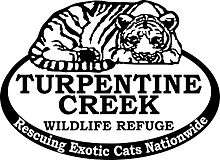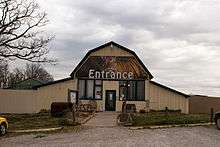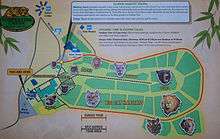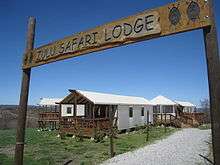Turpentine Creek Wildlife Refuge

Turpentine Creek Wildlife Refuge (TCWR) is a 459-acre (186 ha) wildlife refuge for abused, abandoned, and neglected big cats.[1]
The Eureka Springs, Arkansas, refuge houses 130 (or more) animals. It mainly specializes in tigers, but there are also lions, leopards, cougars, bobcats, black bears, ligers, servals, a monkey,a coatimundi and a grizzly bear.
This refuge is now a United States Department of Agriculture (USDA) licensed facility.
The refuge is open every day of the year (except Christmas) from 9 a.m. until about 5 p.m. (winter) or 6 p.m (summer). Turpentine Creek depends on volunteers and donations.[2][3]
History

The official Turpentine Creek Website states the history as:
In 1978, the Jackson Family acquired their first lion, Bum, while living in NE Texas. Tanya Jackson Smith, current president of TCWR, was only 11 years old at the time. In 1982, they acquired another lion, named Sheila. Although it wasn’t easy taking care of the two lions in their backyard, the Jackson family was successful. Bum and Shelia moved from their home in Hope, Arkansas, to Eureka Springs when the Refuge was first started in 1992. They remained at the Refuge for their entire life.
In December 1991, Katherine Gordon Twiss, a breeder and black market dealer, showed up on the Jackson’s doorstep with 42 big cats crammed into three cattle trailers. She was on the run from the law in Texas and desperately needed to find a home for the cats. A friend of the Jackson family lived on a ranch in Eureka Springs, Arkansas, and offered temporary refuge for the cats. Later the property was bought for a permanent home. The 42 big cats were moved to the nearly 500 acre ranch near Eureka Springs, which later became what today is Turpentine Creek Wildlife Refuge. The labor-intensive job of quickly building temporary cages for the 42 big cats was completed. Twiss was impossible to get along with and moved all her 70 cats and 30 horses that she had picked up from around the country and brought them to the refuge.
It soon became evident, by incoming phone calls from all over the country from "big cat pet owners" looking for a home for their cat, that someone needed to start a refuge, or sanctuary. The Jackson family: Don, Hilda, and Tanya stepped up to this challenge and did what most would only dream of – sold everything; moved over 300 miles; and humbly went to work for the animals.[4]
Today there are over 2 dozen reputable sanctuaries for big cats around the country, and Turpentine Creek Wildlife Refuge stands out as a frontrunner.[5] The United States has thousands of its residents keeping dangerous big cats in their backyards, basements, garages, and warehouses. People acquire these animals as pets, soon find they have made a grave decision, and turn to Turpentine Creek for refuge.[6]
Expansion

In 2012 Turpentine Creek rescued 34 big cats from a breeding facility.[7] To accommodate this massive number of cats a secondary area was built, which is now referred to as "Rescue Ridge". Many of the cats rescued from the facility were not used to human contact. To reduce stress to the animals this area is not open to the public.
Turpentine Creek has spent the past few years working to expand the refuge. The original area, now referred to as the "Compound" that contained smaller cages with cement flooring has been emptied. Turpentine has built spacious, grassy habitats ranging in size from 1/4 acre to 1/2 acre for the animals to live in over the past 14 years.
As of Sept. 16th 2015, all of the small concrete cages that used to make up the majority of Turpentine Creek have been emptied. Sept. 17th 2015, demolition of the old "compound" area began.
Turpentine Creek is also currently building an on-site Veterinary Hospital for the animals who reside at Turpentine Creek. The vet hospital is on Turpentine Creek's property and will make giving the animals medical attention easier. By having a vet hospital on-site there will be less stress to the animals and reduce the risk of the animals, or any human around them, from getting injured.[8]
Internships
Turpentine Creek offers a 6-month internship program for college graduates who have earned degrees in a field of study that is relevant to animal welfare. A degree in Zoology, Biology or related field is preferred, but experience with exotic animal husbandry is sometimes accepted. Currently Turpentine has past interns working at Zoos and Sanctuaries all over the USA and even a few in other countries around the world.

Lodging
Turpentine Creek has six Tent/RV spots and eight suites that guests can stay at overnight. The Safari Lodges are for people 18+, the Okavango is handicap accessible. The Siberian and Bengal suites are for families and can house up to a max of 4 people of any age. The tree house can house up to a max of 4 people ages 5 and up.[9]
Accreditations & Acknowledgments
In 2015 Turpentine Creek reached Verified Status from the Global Federation of Animal Sanctuaries.
Turpentine Creek is a member of AAZK - The American Association of Zoo Keepers - [10]
Turpentine Creek Wildlife Refuge has made Tigers in America's list of "The Best Tiger Sanctuaries in America".[11]
References
- ↑ Visit the Refuge - Turpentine Creek Wildlife Refuge
- ↑ Turpentine Creek Wildlife Refuge Mission Statement
- ↑ Donations to Turpentine Creek Wildlife Refuge
- ↑ "about".
- ↑ "the 411".
- ↑ "Big cats rehabilitated at Turpentine Creek Wildlife Rescue".
- ↑ "Rescue Ridge Article".
- ↑ "Vet Clinic".
- ↑ "Turpentine Creek Tripadvisor".
- ↑ https://www.aazk.org/
- ↑ "Tigers in America".
External links
Coordinates: 36°18′38″N 93°45′26″W / 36.31045°N 93.75713°W